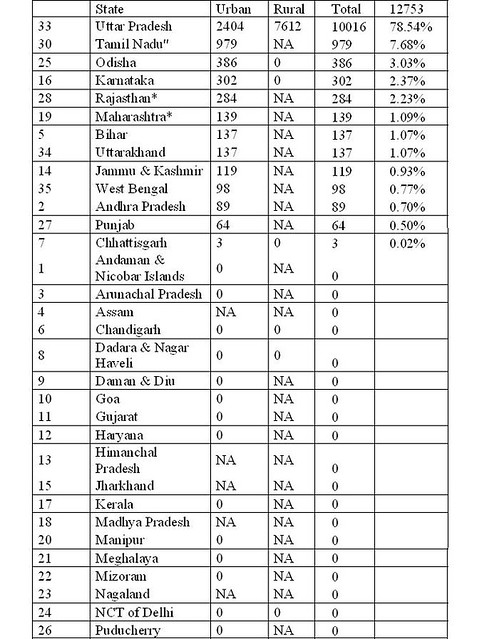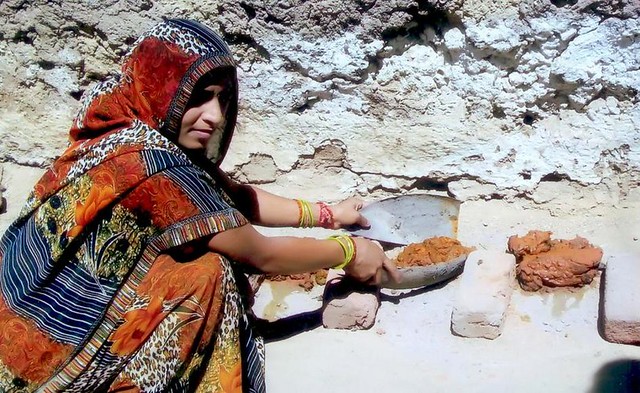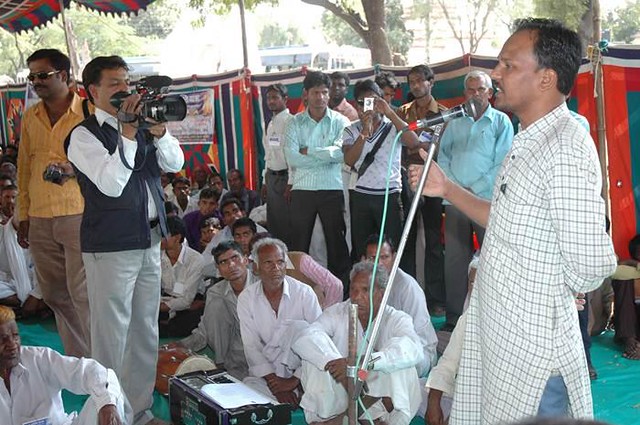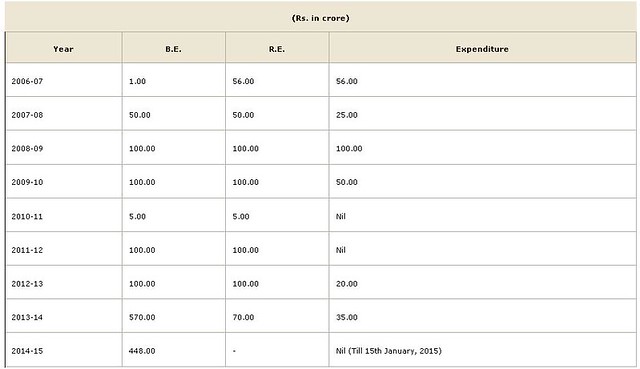Is the government really serious about rehabilitation of manual scavengers?
By Nivedita Khandekar, TwoCircles.net,
New Delhi: It is centuries old, most inhuman of the practices. And unfortunately, despite the rule of law, it is rampant in large pockets, including in the national capital of Delhi, across India.
Manual scavenging – what the Centre even failed to acknowledge exists till the Census 2011 figures held an unhappy mirror – continues unabated more than a year after the ‘Prohibition of Employment as Manual Scavengers and their Rehabilitation Act 2013’, which came into force in February 2014.

Manual scavenging practice from a village in Uttar Pradesh (Photo Credit: Safai Karmchari Andolan)
And circa 2015, the government is still not sure how many persons – almost all of them from lower and lowest of the lower caste – are engaged in this insensitive blot of a profession. While public in general are least bothered, the government is indifferent. Activist in this field are having a harrowing time even convincing the government to do surveys and rehabilitate manual scavengers. Allotment of funds, non-implementation of schemes and most important, lack of punitive measures for non-compliance have simply left much to be desired.

Manual scavenging practice in Bihar (Photo Credit: Safai Karmchari Andolan)
Government data claims there are only 12,753 manual scavengers
According to the information provided by Vijay Sampla, the Minister of State for Social Justice and Empowerment in the Rajya Sabha last week, manual scavengers are found in 13 states. The minister provided a table of state-wise data – contested by activists – which claimed there are 12,753 manual scavengers in India and over 10,000 of them in Uttar Pradesh alone.
The state/UT data as per the latest information available on the basis of survey undertaken in the States/UTs from 13 states is as follows:

A quick look at the table tells even a lay person how faulty and incomplete this data is. Uttar Pradesh has been candid to return a figure of 10,000 plus – although there are more persons involved, activists say – but other large states have either not given any data, resulting in NA, as in case of Delhi and Madhya Pradesh, or simply given nominal figures. For instance, West Bengal has 98 and Punjab has just 64 manual scavengers (More about other states later).
It’s no rocket science to understand that the sole cause for continued practice of manual scavenging is the existence of insanitary latrines. So, ideally, the task at hand should be to identify those places, people involved and rehabilitate them into other livelihoods. However, it is better said than done.
The government – smug after passing the Prohibition of Employment as Manual Scavengers and their Rehabilitation Act 2013 – is sitting on surveys, reports and requests by NGOs and activists working in the field that have provided documentary evidences about the ongoing practices.
For instance, as per the section 5 of the MS Act, 2013, construction of insanitary latrines and engaging of manual scavengers from the date of commencement of the Act i.e. February 6, 2014, is prohibited. The Act also provides for identification of insanitary latrines and their demolition/ conversion into sanitary latrines on a time bound basis.
“But our experience is otherwise. We have submitted number of reports, photo/video documentary evidences, taken officials from the Ministry to the field, but to no avail. The government does not even want to recognise such things exist,” said Bezwada Wilson, national convenor of Safai Karmchari Andolan.
As per the 2013 Act, the municipalities, Cantonment Boards and Indian Railways authorities have been mandated to construct adequate number of community sanitary latrines within a period of three years from the date of commencement of the Act to eliminate the practice of open defecation. And when that happens, automatically the persons working would be rendered unemployed. (Hence), the Act also provides for identification and rehabilitation of the existing manual scavengers.
So far so good. Albeit, as it turns out, all such good things remain only on paper.

Manual scavenging practice from a village in Madhya Pradesh (Photo credit: Safai Karmachari Andolan)
The rehabilitation will happen only when the manual scavengers are identified. Going back to the table above, if we are to believe the government, there are only about 12,753 manual scavengers in India. Only one state – Uttar Pradesh – came forward with a figure of 10,000, if not 100 % accurate but towards reality while the rest of the states either did not conduct the survey or did not do it properly.
For instance, bigger states such as Andhra Pradesh has just 89 persons as manual scavengers while Tamil Nadu has 979, Karnataka has 302, Jammu & Kashmir 119 and Maharashtra 139.
Who would believe that?

Women walking as part of the Maila Mukti Yatra. (Photo credit: Rashtriya Garima Abhiyaan
It was in 2010 when women across the country – who had carried out a Maila Mukti Yatra under the banner of Samajik Parivartan Yatra – had met the then Union Social Justice Minister Mukul Wasnik when the government had audaciously declared there was no manual scavenging remaining in India. As a result of this pressure, the government appointed four committees/task forces in January 2011 to enumerate actual number of people involved in manual scavenging. Things did not move as desired and the government remained reluctant, mostly in denial mode. Then, the Census 2011 data released in 2012 nailed the government lie. The activists had then insisted that the survey should be a joint survey – government official and activists/NGOs together – as no one had any confidence in any of the government machinery.
The ‘House Listing and Housing Census, 2011’ data released by the Registrar General of India in March 2012 provided number of households – more than 25 lakh – by type of latrine facility, including latrines from which night soil is manually removed. It clearly showed that such latrines existed in all states/UTs except in Goa, Sikkim and the UTs of Chandigarh and Lakshadweep.
So, reluctantly the states agreed for the survey. While few started in right earnest, others dragged their feet, more in the denial mode and less due to their capacity to do. The reasons for non-compliance were varied.
Delhi, the national capital territory of Delhi – right under the nose of the Central government – is a classic example of how the babudom finds excuses. For all the months that no work was done for carrying out the survey, Raju Sharsar, the chairman of the Delhi Commission for Safai Karmcharis (DCSK) blames the President’s Rule in Delhi during last one year. “We are still carrying out the survey. There was literally no work going on during last one year due to President’s Rule. (Now) We are hopeful that it will be completed in 60 days,” Sharsar said.
And what about rehabilitation of people who have already been identified? “Sorry, no work has started for rehabilitation,” was Sharsar’s candid reply.
Just how far away from the reality the state governments are is exposed by Ashif Sheikh of the Rashtriya Garima Abhiyaan (National Campaign for Dignity). “Census 2011 threw up a figure of 27 lakh dry toilets across India. Even (then Minister) Jairam Ramesh agreed to conduct a survey in census towns. (But) states such as Rajasthan, Madhya Pradesh straightaway disagreed and claimed the Census data was wrong,” Sheikh said, adding, “After much persuasion, some states agreed for survey at the district-level. Some of them are not agreeing to it even on paper, forget on ground.”

Ashif Sheikh of Rashtriya Garima Abhiyaan during the Delhi meeting after Maila Mukti Yatra. The meeting was attended among others by then union minister Jairam Ramesh (Photo credit: Rashtriya Garima Abhiyaan)
He also pointed out how whatever is being done under the name of ‘survey’ is hogwash. “The ongoing survey is being conducted only at the Census towns. It cannot be termed as state-wide data as no survey is happening across remaining areas of the states. Moreover, the definition (of a scavenger) under the 2013 Act has been widened to include anybody who is doing manual cleaning. It includes sewer workers manually cleaning septic tanks, sewer/manholes, it includes those safai karmcharis employed by Indian Railways to clean railway tracks/platforms manually etc. Whatever surveys are being done, are considering only the traditional form of manual scavenging.”
The survey in rural areas is to be done by the Socio Economic Caste Census (SECC), which will throw up yet another set of figures and put rest to unusual figures presented by the government in the Parliament, activists believe. But that too has not started yet.
No survey, budget lapses
The first year – 2011 – the government had allotted Rs 65 crore for the survey. March 2012, the government said, it could not spend the money. “Next year, the budget was revised to Rs 10 crore, same was the reply in April 2012. Again in March 2013, nothing,” Wilson pointed out.
A look at the data on the Ministry of Social Justice is testimony to the apprehension of the activists. Under what the government calls as the ‘Self Employment Scheme for Rehabilitation of Manual Scavengers (SRMS), introduced in 2007 with an aim to rehabilitate “remaining” manual scavengers and their dependents in a “time-bound” manner, the budgetary spend was as follows:
As per the buget for 2015-16, the government has earmarked Rs 460 crore for the SRMS despite the fact that data from years 2011-12 onwards showed a declining trend in expenditure.
According to the government’s revised scheme, those identified as manual scavengers – and ironically, only one from each family – are provided one-time cash assistance. “The identified manual scavengers and their dependents are provided project based back-ended capital subsidy up to Rs 3,25,000 and concessional loan for undertaking self-employment for a period of up to two years, during which a stipend of Rs 3,000 per month is also provided,” reads the government scheme document.
But as with other government claims, activists punched holes in this claim too. Sheikh claimed, “Rs 280 crore has been spent till date on 3.4 lakh beneficiaries, the government claims. But if we see the number of people who are actually rehabilitated, it is far lower – just 81,000 till date.”
Wilson said his organisation estimated there are close to three lakh people directly involved in manual scavenging as per the traditional/conventional manner and the numbers are likely to increase exponentially as and when those defined as scavengers under the new definition are included.
The only good thing – if at all it can be termed as one – is the government admission in the same Parliament reply: “Existence of manually serviced latrines in the States/UTs points to the fact that the practice of manual scavenging is yet to be fully eliminated.”
Okey, so what do you plan to do, dear government?
But this semblance of an assurance does not seem to ensure that further implementation is set to be any better.
Explaining the unused funds at the end of each fiscal, V K Parwanda, deputy general manager of the National Safai Karmcharis Finance and Development Corporation (NSKFDC), said, “The survey started late and is further delayed. (So) we are late in disbursing one-time assistance for the beneficiaries. We are now asking for comprehensive proposals (for another round of survey) from states for a fresh realistic assessment.”
The Ministry of Social Justice did hold a meeting on March 18 wherein the Centre asked all the states again to complete the survey as early as possible. Parwanda assured that the government was keen on rehabilitating each and every manual scavenger and claimed, it had started publicity till village level for identifying such persons, preventing them to continue such work and rehabilitate them. The ministry has claimed to have put in place a helpline for the purpose.
Will that work? Does that show commitment enough? As per Section 21 of the 2013 Act, Executive Magistrates, who have been conferred judicial powers of first class, are empowered to try any offences committed under the Act.
Fair enough. But government has no data whatsoever if any action has ever been taken under this section.
But the problem is not even that. It is not to do with what offence anyone commits under the Act, but more to do with the lack of action – rather lack of interest – by the government authorities in doing what they are supposed to do. Wilson pinpointed the problem: “Unfortunately, there is no punishment in the Act for non-performance by government officials not keen on doing what they are supposed to do!”


